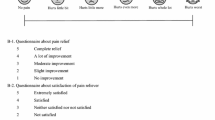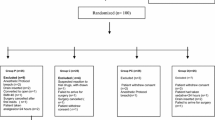Abstract.
This study evaluated the analgesic efficacy of administering preoperatively rofecoxib or naproxen sodium to patients undergoing abdominal hysterectomy. A randomized, double-blinded prospective study was conducted with 60 women undergoing elective abdominal hysterectomy under general anesthesia. Patients were randomly allocated into one of three equally sized groups. Patients in the first group received rofecoxib 50 mg 1 h before operation (group R), patient in the second group received naproxen sodium 550 mg 1 h before surgery (group N) and patients in the third group received a placebo tablet in the same time (group P). Total amount of used morphine mixture was higher in placebo group (93±6 ml) than in the group R (50±4 ml) and group N (64±6 ml). There were significant difference for total amount of used morphine mixture between group P and other two groups. There was significant difference in the volumes of morphine mixture used in the first 12 h in group P and other two groups. The occurrence of side effects such as, dyspepsia, epigastric discomfort, heartburn, were similar in group R and group P. However, this side effects were increased in group N. Rofecoxib receiving preoperatively was provided clinical efficacy for postoperative pain control and well tolerated for gastrointestinal side effects comparable with naproxen sodium.
Similar content being viewed by others
References
Bakhle YS, Botting RM (1996) Cyclooxygenase-2 and its regulation in inflammation. Mediators Inflamm 5:305–323
Bloomfield S, Barden T, Mitchell J (1974) Analgesic efficacy of naproxen in postpartum pain. Clin Pharmacol Ther 15:201
Brown C, Sevelius H, Wild V (1984) A comparison of single doses of naproxen sodium, morphine sulfate and placebo in patients with postoperative pain. Curr Ther Res 35:511–518
Cannon GW, Caldwel JR, Holt P (2000) Rofecoxib, a specific inhibitor of cyclooxygenase 2, with clinical efficacy comparable with that of diclofenac sodium. Arthritis Rheum 43:978–987
Comfort VK, William E, Rooney ME, Yip RW (1992) Naproxen premedication reduces postoperative tubal ligation pain. Can J Anaesth 39:349–352
Dahl JB, Kehlet H (1991) Non-steroidal anti-inflammatory drugs: rationale for use in postoperative pain. Br J Anaesth 66:703–712
Day R, Morrison B, Luza A, Castaneda O, Strusberg A, Nahir M (2000) A randomized trial of the efficacy and tolerability of the COX-2 inhibitor rofecoxib vs ibuprofen in patients with osteoarthritis. Arch Intern Med 160:1781–1787
Elhakim M, Nafie M (1995) I.v. tenoxicam for analgesia during caeserean section. Br J Anaesth 74:643–646
Gabriel SE, Jaakkimainen L, Bombardier C (1991) Risk for serious gastrointestinal complications related to use of nonsteroidal anti-inflammatory drugs: a meta-analysis. Ann Intern Med 15:787–796
Gilberg LE, Harsten AS, Stahl LB (1993) Preoperative diclofenac sodium reduces post-laparoscopy pain. Can J Anaesth 40:406–409
Hawkey C, Laine L, Mortensen E (1999) Treatment of osteoarthritis with rofecoxib, a cyclooxygenase-2 (COX-2) specific inhibitor, was associated with a lower incidence of gastroduodenal ulcers compared to ibuprofen and was comparable to placebo treatment (abstract). In Proceedings of the 14th Congress, 6–12 June, Glascow
Hodsman NBA, Burns J, Blyth A, Kenny GNC, McArdle CS, Rotman H (1987) The morphine sparing effects of diclofenac sodium following abdominal surgery. Anaesthesia 42:1005–10058
Laine L, Harper S, Simon T (1999) A randomized trial comparing the effects of rofecoxib, a cyclooxygenase 2-specific inhibitor, with that of ibuprofen on the gastroduodenal mucosa of patients with osteoarthritis. Gastroenterology 117:776–783
Laine L, Hawkey C, Harper S (1999) Effects of the COX-2 specific inhibitor (C-2SI) rofecoxib on ulcer formation: a double-blind comparison with ibuprofen and placebo (abstract). Gastroenterology 116:A232
Langman M, Jensen D, Harper S (1999) Lower incidence of clinically evident upper-GI perforations, ulcers and bleeds in patients treated with rofecoxib vs. Nonspecific cyclooxygenase inhibitors (abstract). Gastroenterology 116:A232
Moote C (1992) Efficacy of nonsteroidal anti-inflammatory drugs in the management of postoperative pain. Drugs 44:14–30
Parker RK, Holtmann B, Smith I, White PF (1994) Use of ketorolac after lower abdominal surgery. Effect on analgesic requirement and surgical outcome. Anesthesiology 80:6–12
Raja SN, Meyer RA, Campbell JN (1988) Peripheral mechanisms of somatic pain. Anesthesiology 68:571–590
Reuben SS, Bhopatkar S, Maciolek H, Joshi W, Sklar J (2002) The preemptive analgesic effect of rofecoxib after ambulatory arthroscopic knee surgery. Anesth Analg 94:55–59
Revil SL, Robinson JO, Rosen M, Hogg MTJ (1976) The reliability of a linear analogue for evaluating pain. Anaesthesia 31:1191–1198
Runkel R, Forchielli E, Boost G (1973) Naproxen metabolism, excretion and comparative pharmacokinetics. Scant J Rheumatol 2:29–36
Sevarino FB, Sinatra RS, Paige D, Ning T, Brull SJ, Silverman DG (1992) The efficacy of intramuscular ketorolac in combination with intravenous PCA morphine for postoperative pain relief. J Clin Anesth 4:285–288
Simon LS, Lanza FL, Lipsky PE (1998) Preliminary study of the safety and efficacy of SC-58635 a novel cyclooxygenase 2 inhibitor efficacy and safety in two placebo-controlled trials in osteoarthritis and rheumatoid arthritis and studies of gastrointestinal and platelet effects. Arthritis Rheum 41:1591–1602
Souter AJ, Fredman B, White PF (1994) Controversies in the perioperative use of nonsteroidal antiinflammatory drugs. Anesth Analg 79:1178–1190
Woolf CJ (1983) Evidence for a central component of post-injury pain hypersensitivity. Nature 306:686–688
Woolf CJ, Chong MS (1993) Preemptive analgesia: treating postoperative pain by preventing the establishment of central sensitization. Anesth Analg 77:362–379
Author information
Authors and Affiliations
Corresponding author
Rights and permissions
About this article
Cite this article
Çelik, J.B., Tuncer, S., Reisli, R. et al. A comparative study of the effect of rofecoxib (a COX 2 inhibitor) and naproxen sodium on analgesic requirements after abdominal hysterectomy. Arch Gynecol Obstet 268, 297–300 (2003). https://doi.org/10.1007/s00404-002-0377-5
Received:
Accepted:
Published:
Issue Date:
DOI: https://doi.org/10.1007/s00404-002-0377-5




